14 Interesting Facts About Mascots
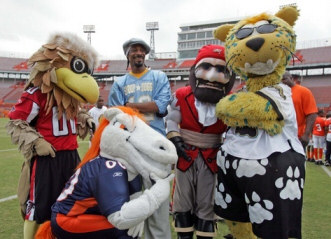 In America, mascots abound. Every college, high school, and sports team has
one. The mascot often becomes a symbol for the school or the team itself. You
can buy merchandise sporting the mascot, everything from key chains to sweaters
and other clothing. Kids and adults alike enjoy the entertainment provided by
the mascots during sporting events. Whether its dancing, skits, purposefully
falling, or mocking the audience, every mascot has its own performance routine
that engages and entertains audiences of all ages. Mascots are not there just to
cheer on the team, they have diversely demanding position requiring them to
entertain constantly. However, their history and tradition are strongly tied to
luck, courage and fighting. In America, mascots abound. Every college, high school, and sports team has
one. The mascot often becomes a symbol for the school or the team itself. You
can buy merchandise sporting the mascot, everything from key chains to sweaters
and other clothing. Kids and adults alike enjoy the entertainment provided by
the mascots during sporting events. Whether its dancing, skits, purposefully
falling, or mocking the audience, every mascot has its own performance routine
that engages and entertains audiences of all ages. Mascots are not there just to
cheer on the team, they have diversely demanding position requiring them to
entertain constantly. However, their history and tradition are strongly tied to
luck, courage and fighting.
Many college mascots are steeped in tradition and school pride, making it
hard to separate the two. Although most mascots today are people in costume, a
few teams still have live mascots, like USC's Traveler (a horse), University of
Colorado's Ralphie the Buffalo, Texas A&M's Reveille the Collie, and University
of Texas' Bevo the Longhorn. Being the mascot of a school (or being the
caretaker) is considered one of the greatest honors. Colleges have the longest
tradition of mascots where a lot of fans and players are almost superstitious
about them, seeing them as a powerful symbol. Colleges are famous for their
immersion into tradition and history. Mascots serve as powerful symbols of
school legacy and assist in unifying sports teams with pride.
Despite their tradition or longevity, mascots are not just about
entertainment. In fact, although they tend to have a deeper association with
sporting events, mascots can be found all over the place. Mascots also serve as
symbols for corporations. Ronald McDonald, Wendy, Toni the Tiger, Trix the
Rabbit, and the MGM Lion are all examples of famous corporate mascots. Famous
mascots often make appearances at important community events like the grand
opening of stores, holiday celebrations, and commercials. Some even visit a
children's hospital to raise the poor kids' spirits. There are many more little
known facts about the mascot and its rich tradition seeped in symbolism.
14) Cavemen had
Mascots
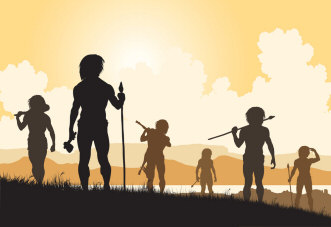 The idea of the mascot is steeped in history and tradition that can be traced
all the way back to the cavemen and early tribal societies. These ancient
societies worshiped many different deities associated with nature and animals.
They often would ask these deities, symbolized by animals, for goodwill. Spirit
dances with masked members of the tribe were often performed in order to ask for
a successful hunt, bountiful harvest, rain or fertility. The men in masks
represented the deity or god who would provide the good luck to the tribe.
Through dancing in the masks they connected with the deity, who would then hear
their plea. The idea of the mascot is steeped in history and tradition that can be traced
all the way back to the cavemen and early tribal societies. These ancient
societies worshiped many different deities associated with nature and animals.
They often would ask these deities, symbolized by animals, for goodwill. Spirit
dances with masked members of the tribe were often performed in order to ask for
a successful hunt, bountiful harvest, rain or fertility. The men in masks
represented the deity or god who would provide the good luck to the tribe.
Through dancing in the masks they connected with the deity, who would then hear
their plea.
A natural transition was using symbols of animals as luck to do well in
sporting events. Just as the men in masks symbolized the deity being worshiped,
traditional mascots are often full of symbolism. They often symbolize traits the
team desire, like courage or ferocity. By channeling the energy of the mascots,
the team can go out on the field and beat their competition. The dancing of the
mascots also doesn't stray too far from the idea of the spirit dances. The
mascot's job today may be more about entertaining, but many teams still put a
lot of superstition and belief into their mascots. Just as a spirit dance will
bring fertility or luck in the hunt, a mascot's dance can bring a touchdown,
home run, or other great plays.
13) The Word
Mascot comes from French
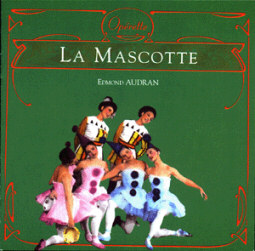 The idea of a good luck charm or symbol had been around since ancient times,
however the word mascot is relatively new. Although mascots have a heavy
association with American sports, the word itself came from France. The first
recording of the original French word 'mascotte,' which means lucky charm, was
in 1867. It was derived from the Provencal 'mascoto' which meant witchcraft,
charm, or amulet, a diminutive of the word for witch 'masco.' It also has its
roots in Latin. The lucky charm or talisman spoken about at this time were not
humans wearing animal costumes. Instead, they tended to be charms or something
small a person would carry for good luck. The idea of a good luck charm or symbol had been around since ancient times,
however the word mascot is relatively new. Although mascots have a heavy
association with American sports, the word itself came from France. The first
recording of the original French word 'mascotte,' which means lucky charm, was
in 1867. It was derived from the Provencal 'mascoto' which meant witchcraft,
charm, or amulet, a diminutive of the word for witch 'masco.' It also has its
roots in Latin. The lucky charm or talisman spoken about at this time were not
humans wearing animal costumes. Instead, they tended to be charms or something
small a person would carry for good luck.
The opera "La Mascotte" popularized the word in 1880 in France. The opera is
about a farmer and a Prince with very bad luck who search for a mascot. Instead
of a more traditional charm, they are searching for an angel sent by God to
battle Evil as their mascot to turn their fortunes around. They find it in the
form of a woman, Bettina. They battle over Bettina and her love, trying to keep
her pure so she will remain their mascot. Much drama ensues until a successful
ending is reached. As a popular opera, "La Mascotte" soon made its way to
England, where its name was Anglicized into "The Mascot."With help from the
opera, the word mascot soon became part of the vernacular as early as 1881.
12) The First
Mascots were Inanimate Objects
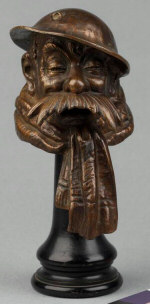 Mascots now have a strong tradition of being animals symbolizing the team or
company they represent. However, initially mascots were locks of hair or some
other inanimate object that brought the bearer luck. Although the opera "The
Mascot" was about a woman as a mascot, when the word first appeared, the word
would be heavily associated with small amulets or talismans which the bearer
would wear or keep for good luck or even fertility. This would be similar to
carrying rabbit's feet for luck or even picking up a lucky penny. Although some
would continue to call them lucky charms rather than mascots, these tokens and
talisman were said to bring the bearer good luck and protect against evil in the
same way a mascot would. The figureheads on the front of early sailing ships
that were carved to keep the ship safe is another example of early mascots. Mascots now have a strong tradition of being animals symbolizing the team or
company they represent. However, initially mascots were locks of hair or some
other inanimate object that brought the bearer luck. Although the opera "The
Mascot" was about a woman as a mascot, when the word first appeared, the word
would be heavily associated with small amulets or talismans which the bearer
would wear or keep for good luck or even fertility. This would be similar to
carrying rabbit's feet for luck or even picking up a lucky penny. Although some
would continue to call them lucky charms rather than mascots, these tokens and
talisman were said to bring the bearer good luck and protect against evil in the
same way a mascot would. The figureheads on the front of early sailing ships
that were carved to keep the ship safe is another example of early mascots.
In the 19th Century, lucky animals began to take over from these smaller
tokens, leading the way for the more common animal mascots found in sports. The
same superstition that leads to people to believe in all sorts of lucky charms,
from rabbits feet to evil eyes to St. Jude medals also finds its way into
sports. Sports players are famously superstitious, wearing their lucky socks or
not wanting to change any part of the routine in case it will bring bad luck. It
is only natural that their mascots would represent many of the same tokens of
good fortune and luck as the traditional mascot, or lucky charm.
11) Schools have
Used Mascots since the 1800s
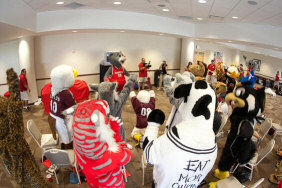 With the rise of intercollegiate sports in schools, mascots easily found
themselves in colleges and high schools around the country, starting as early as
the 1800s. As schools began to compete, a sense of pride and school spirit
emerged. Beating the other schools in the competition would add honor and
prestige to your University, along with bragging rights. A mascot was an easy
way to distinguish the schools out on the fields. Additionally, they added
symbolism to the team, either its own characteristics or tokens of luck. They
could also install fear or awe in another school. With the rise of intercollegiate sports in schools, mascots easily found
themselves in colleges and high schools around the country, starting as early as
the 1800s. As schools began to compete, a sense of pride and school spirit
emerged. Beating the other schools in the competition would add honor and
prestige to your University, along with bragging rights. A mascot was an easy
way to distinguish the schools out on the fields. Additionally, they added
symbolism to the team, either its own characteristics or tokens of luck. They
could also install fear or awe in another school.
Yale was the first, with a bulldog named "Handsome Dan" who was adopted in
1889. The rest of the Ivy League Universities soon followed. It was only natural
that the highly competitive Ivy Leagues would want to find ways to distinguish
themselves and find creative ways to make their schools unique. It was only
natural that the rest of the schools would follow their examples, as they did in
academics and many other policies.
10) The First
School Mascots were Real Animals
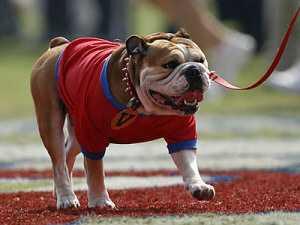 When deciding to incorporate mascots onto the fields, live animals were first
used. Animals as entertainment have been used for centuries. The ancient Roman
Gladiator fights are infamous for their use of animals. Throughout Europe animal
fights continued as entertainment well into more modern times. Even today,
against many animal rights groups, animals are still used as entertainment in
circuses and other more devastating ways like fighting. When deciding to incorporate mascots onto the fields, live animals were first
used. Animals as entertainment have been used for centuries. The ancient Roman
Gladiator fights are infamous for their use of animals. Throughout Europe animal
fights continued as entertainment well into more modern times. Even today,
against many animal rights groups, animals are still used as entertainment in
circuses and other more devastating ways like fighting.
This traditional entertainment found its way into sports as teams decided to
bring extra entertainment to fans through bringing in live animals. They would
often choose animals for symbolic purposes. For example, a common theme was
attempting to spread fear to the opposing teams. Teams often chose predators
that would roar or do other intimidating things to strike fear in their
opponents. Although there is much opposition by societies like PETA, 33 schools
still use live mascots today. Some of these are domesticated animals, like dogs
or cows. Others use more exotic species, like buffalo or Bengal tigers.
9) The Muppets
Inspired Modern day Mascots
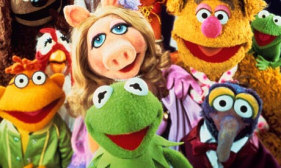 When Jim Henson created his puppets, he probably didn't envision sports mascots
to follow his example. However, these puppets opened up new possibilities for
mascots available for teams: larger than life, cute and adorable animals with a
human inside. This made them more approachable and likeable, and created whole
new possibilities for marketing for team owners. When Jim Henson created his puppets, he probably didn't envision sports mascots
to follow his example. However, these puppets opened up new possibilities for
mascots available for teams: larger than life, cute and adorable animals with a
human inside. This made them more approachable and likeable, and created whole
new possibilities for marketing for team owners.
The first of these was the Philadelphia Phillies' mascot Phillie Phanatic.
The Phanatic was made by Bonnie and Wayde Erickson, a couple who had worked for
Jim Henson before creating their own shop making full body costumes and puppets.
Jim Henson remained a client of theirs until his death. Influenced by San
Diego's famous chicken (a man paid by a radio station to make appearances in a
chicken costume), the Phillies wanted a family friendly mascot that would engage
audiences and entertain kids. They contacted the Ericksons to create a costume
for them and a new style of mascot was born.
|
Mascot of 1968 at the Winter Olympics in Grenoble,
France:
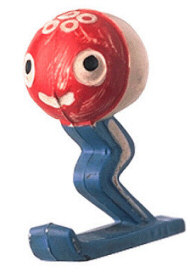
|
8) The
Olympics' Mascot Changes
The Olympics' mascot changes every time because it must symbolize the host city.
The first Olympics mascot to debut, although unofficial, was in 1968 at the
Winter Olympics in Grenoble, France. A man on skis names Schuss made up the
first mascot for the Olympic Games. The 73rd session of the Olympic committee
approved the idea for the Olympic mascot. The following summer games in Munich
in 1972 debuted the first official Olympic mascot, Waldi a German Dachshund.
Each year, it is up to the host country to create an original mascot that
symbolizes the Olympic spirit. By incorporating the values of the Olympics with
the history and culture of the host city a mascot is put together. Additionally,
it is a tool to add festivity, spirit and entertainment to the games.
Originally staying with the theme of animals found indigenous in the host
country, Spain changed the rules when they debuted Cobi. Cobi is an avant-garde
dog created by artist Javier Mascal for the 1992 games. The idea of using more
abstract ideas for the mascots took off. Since then, the mascots have been based
on people, animals, folklore, mythical creatures, and even imaginary or abstract
figures. Not every mascot is enjoyed, and many have been criticized for being
odd. Sometimes, it is hard to see the connection to the host country. However,
creating the mascot for the games has become a special part of the event, much
like the opening ceremony. It allows the host country to impart some of its
culture and ideas to the rest of the world.
7) Professional
Sports did not use Mascots until the 1960s
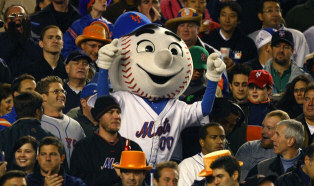 Although mascots were a part of high school and college sports since the 1800s,
professional sports didn't start using mascots until the 1960s. The first
professional sports team to use a mascot was the New York Mets. Their mascot was
an oversized fan with a baseball for a head named Mr. Met. Many of the first
official professional sports mascots were similar "super fans" that entertained
and provided cheer for children. The combination of the new, Muppet like mascots
and a desire to begin hooking younger fans led the way to a new form of
marketing. Not only were mascots entertaining and symbolic, they also allowed
for teams to sell items based upon the mascot. Although mascots were a part of high school and college sports since the 1800s,
professional sports didn't start using mascots until the 1960s. The first
professional sports team to use a mascot was the New York Mets. Their mascot was
an oversized fan with a baseball for a head named Mr. Met. Many of the first
official professional sports mascots were similar "super fans" that entertained
and provided cheer for children. The combination of the new, Muppet like mascots
and a desire to begin hooking younger fans led the way to a new form of
marketing. Not only were mascots entertaining and symbolic, they also allowed
for teams to sell items based upon the mascot.
Today, the most popular mascots remain the silly, larger than life variety.
Successful must be easily recognized, likeable, and have a strong association to
the team. Mr. Met remains a top mascot in professional sports. Other popular
mascots are PhilliePhanatic, Benny the Bull, the San Diego Chicken and Wally the
Green Monster.
|
Choko Group Mascot School in Japan:
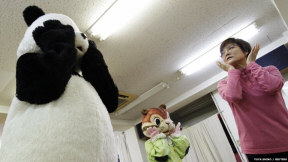
|
6) You can go
to Mascot School
In San Antonio, there is a Professional Mascot School. For $250, you can go to
San Antonio and learn the secrets behind being a professional mascot.
Performance, character acting, and other important aspects of the job are
taught. It takes a lot of effort and thought into becoming a mascot, so finding
a school that assists in the process is only natural. Mascots can make anywhere
from $25,000 a year to six figures, depending on the team you mascot for.
There is also a school in Japan called Choko Group Mascot School. When the
call for character actors and mascots rises in Japan, the school opened to teach
people how to perform and become successful as professional mascots.
5) There is a
Mascot Hall of Fame
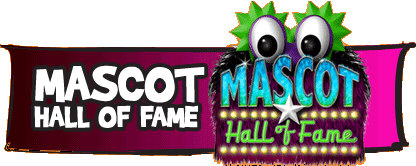 David Raymond, the original PhilliePhanatic from 1978-1993, decided to honor the
hard work of mascots. He started a Hall of Fame that as of now is only online.
Since 2005, mascots get elected through a committee made up of performers,
sports executives, and other members of the mascot community. A public vote of
the final 6 nominees has a small say in the final winner. Community service and
honoring the community is an important aspect of being a part of the mascot hall
of fame. David Raymond, the original PhilliePhanatic from 1978-1993, decided to honor the
hard work of mascots. He started a Hall of Fame that as of now is only online.
Since 2005, mascots get elected through a committee made up of performers,
sports executives, and other members of the mascot community. A public vote of
the final 6 nominees has a small say in the final winner. Community service and
honoring the community is an important aspect of being a part of the mascot hall
of fame.
The Mascot Hall of Fame does not honor only mascots in professional sports
but it also celebrates professional characters and collegiate characters.
Additionally, some mascots have made it into sports hall of fame. Youppi!, the
San Diego Chicken, and PhilliePhanatic are on display in the Baseball Hall of
Fame.
The Mascot at Texas A&M is the Highest Member of the Corps of Cadets A
perfect example of the revere mascots have as symbols of school spirit is Texas
A&M's mascot, Reveille. Reveille has the highest position in the school. As any
Aggie knows, the Corps of Cadets has a long, important history with the school.
Having the mascot as the head of the Corps does not sound too weird, until you
realize the mascot is a collie. Reveille is the only cadet to bear five silver
diamonds, a very high honor. Company E-2 of the Corps of Cadets takes care of
Reveille. If she decides to sleep in one of their beds, the cadet must sleep on
the floor. If she visits a class and barks, the class must be immediately
dismissed. Cadets must call Reveille "Miss Rev, ma'am." All Reveilles are buried
at the north end of the Aggie football field, facing the scoreboard.
Although all universities cherish their mascot and taking care of it, very
few actually get to be in charge like Reveille. Many of the live animal mascots
require special treatment, and it is considered an honor to get to help.
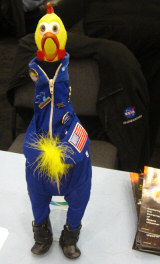 4) NASA Has a
Mascot 4) NASA Has a
Mascot
Sports teams and colleges are not the only ones who have mascots. Many
companies, military units, and corporations have mascots. NASA's mascot is
Camilla Corona SDO, a rubber chicken that helps with outreach and education. She
has her own blog and Facebook page where fans, students and teachers can connect
with her missions, including those they can do at home. One example is the Train
Like an Astronaut initiative, which is a part of the "Let's Move" initiative.
She also shares information on space exploration, astral phenomena, and
eclipses.
She began when a group of high school students sent her into space. Now, with
the help of many NASA employees and astronauts, she trains to be an astronaut
and brings her experience back to the classroom, as a CNN blog demonstrated.
3) The
Norwegian Royal Guard's Mascot is a King Penguin
On a visit to Edinburgh in 1972, the Norwegian Royal Guard's regimental band
decided to adopt a King Penguin. They named it Nils Olav and it became a part of
the Royal Guard. Instead of traveling with the band, it remains at the Edinburgh
Zoo. During every trip to Britain by the band or another branch of the Guard,
the penguin is formally promoted one rank. It has even been knighted. However,
the current Nils Olav is not the original, which died in the 1980s and was
replaced. However, the symbolic rankings were given to the new Nils Olav, who
continues to rise in ranking in the Royal Guard.
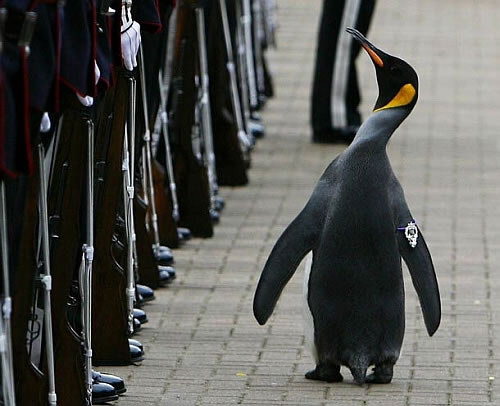
Currently a knight and Colonel-in-Chief, the King Penguin's history began
with a gift from a Norwegian citizen to the Edinburgh Zoo of a King Penguin. It
began what remains a strong friendship between Scoto and and Norway. Nils Olav
continues to rise in the ranks to do "outstanding service and good behavior,"
and he remains a beloved part of the regiment.
2) Smokey the
Bear is a Mascot
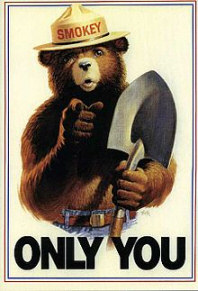 Everyone knows Smokey the Bear and McGruff the Crime Dog, but because of the
heavy association of mascots with sports team, it is lost that they are actually
mascots. The United States Forest Service decided they wanted something to help
educate children and the public about the danger of forest fires. They decided
to create the mascot Smokey the Bear. The first Smokey the Bear images debuted
in 1944 with a slogan that said "Smokey Says-Care Will Prevent 9 out of 10
Forest Fires." It was eventually changed to "Remember…Only YOU can Prevent
Forest Fires," and more recently, "Only You Can Prevent Wildfires." About 95% of
adults and 77% of American children recognize Smokey the Bear. Everyone knows Smokey the Bear and McGruff the Crime Dog, but because of the
heavy association of mascots with sports team, it is lost that they are actually
mascots. The United States Forest Service decided they wanted something to help
educate children and the public about the danger of forest fires. They decided
to create the mascot Smokey the Bear. The first Smokey the Bear images debuted
in 1944 with a slogan that said "Smokey Says-Care Will Prevent 9 out of 10
Forest Fires." It was eventually changed to "Remember…Only YOU can Prevent
Forest Fires," and more recently, "Only You Can Prevent Wildfires." About 95% of
adults and 77% of American children recognize Smokey the Bear.
One legend about the origins of Smokey the Bear is that he is based on a
small bear cub that was rescued after a fire in New Mexico. He was caught in a
bad fire and burned. The firefighters did not know what to do with him, and the
cub ended up in the home of a local rancher. Eventually, the New Mexico
Department of Game and Fish learned of the cub and picked him up and sent him to
a vet for treatment.
|
Wilbur the Wildcat and his wife Wilma:
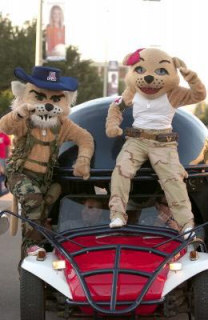
|
1) Some
Mascots are Married
Although mascots began as simple symbols of domination often through live
animals, the rise of the fun centered, entertaining mascots brought an
opportunity for double the fun. No longer forced to remain a one-man show, some
mascots now have a spouse or partner. The two mascots provide twice the fun and
entertainment. A pair can create a fun and entertaining show combining many
skills and skits.
The University of Arizona has the only collegiate married mascots Wilbur the
Wildcat and his wife Wilma. They were married on November 21, 1986. Other
married mascots include Dartmoth College's unofficial mascots Keggy and Kelley
the Keg, Hamm's beer Bear and Harley bear for Hamm's, and Boston Red Sox's Polly
and Wally the Green Monsters.
Final Words
Mascots are a fun addition to any sporting event. With a long history in
American culture, especially through collegiate sports, they have begun to
invade the rest of the world. Although the most readily associated mascots tend
to be with sports, many large corporations have their own special mascot.
Mascots are a fun and easy way for companies to reach children, either for
education or entertainment. Mascots also make it easy for consumers to make a
connection between a brand and certain characteristics.
Although some once loveable mascots do not have the engagement they once did,
companies and sports team continue to rely on mascots to be ambassadors of their
product. Sometimes, companies will change their mascot to reengage customers.
Deep seeded in the tradition of lucky charms and ancient spirituality, now the
mascot has become more of a corporate symbol. However, the superstition and
symbolism once attributed to a mascot still abides. Even though entertainment
has become a priority, the strong traditions of collegiate sports and their
mascots demonstrate the true roots of the mascot. For universities, the mascot
remains a place to channel luck and power so the team will successfully beat
their rivals.
Cool Sport Stuff
14 Interesting Facts About Mascots |